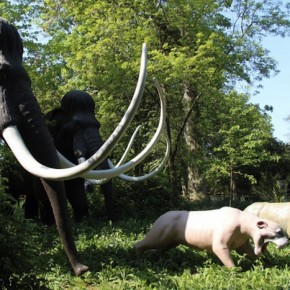Nature is more than “red in tooth and claw.” Survival of the fittest is commonly seen as organisms battling with each other for scarce resources, but it may also involve multiple species working together for the benefit of all.
Darwin’s followers have perpetuated the bloody, warlike view of adaptation since the earliest days of evolution. Perhaps this image has stuck because it is so readily applied to humans, with their penchant for destruction and genocide.
The reality, though, is more straightforward. It’s easier for scientists to study how one species adapts to a changing environment, than to look at the interactions among all species within an ecosystem.
Organisms, however, live in diverse communities, alongside many other species, making the single species approach somewhat limited in its usefulness.
Survival of the Fittest in Bacterial Communities
While most research into evolutionary adaptation has focused on single species, two recent studies have attempted to understand how species can influence each other’s evolution. This type of evolutionary change, in which interactions among species affects how each adapts to the environment, is known as coevolution.
The first study, published in PLoS Biology, involved growing five species of bacteria in a laboratory. The bacteria were grown both individually, and then together in a community.
The researchers, from Imperial College London, measured how the feeding habits of the bacteria changed over 70 generations.
When the bacteria were grown in a mixed community, they evolved to share their resources more efficiently. Instead of competing for the same resources—as seen with bacteria grown individually—bacteria living within a community used each other’s waste products as sources of food and nutrients.
This simple experiment shows that adaptation depends upon many factors, including the other species present in the community. It also highlights the importance of coevolution in enhancing the functioning of the ecosystem.
“Because all species live together with many hundred other species present, the kind of phenomena observed here are likely to apply widely,” lead author Diane Lawrence told EurekAlert.
Recreating Earth 400 Million Years Ago
This type of mutually beneficial partnership between species is readily apparent in the interaction between plants and fungi. In fact, fungi played an important role in the evolution of plants.
Using state-of-the-art growth chambers, scientists from the University of Sheffield recreated the environmental conditions from 400 million years ago—when plants were making their first foray onto land. This, the scientists hoped, would help explain how plants colonized terrestrial habitats before they had evolved roots.
Today, plants and soil fungi live together in a symbiotic relationship—each benefits from the other’s unique abilities. Fungi extract phosphorus from the soil and provide it to the plants; this promotes growth of the plants. In exchange, the fungi receive sugars created by the plants during photosynthesis—the chemical reaction that uses the energy of sunlight to convert carbon dioxide to oxygen.
Since ancient plants no longer exist, the scientists used modern stand-ins for the various stages in the evolution of plants—liverworts for the earliest plants to venture out of the water; ferns as representatives of the first plants with roots and leaves; and a common garden weed for the most recently evolved plants.
Intimate Relationship of Plants and Fungi
Using the special growth chamber, the scientists examined the relationship between fungi and the different types of plants, in conditions mimicking today’s atmospheric conditions, and those from 400 million years ago.
In this way, they began to better understand the unique plant-fungi partnership that began half a billion years ago, when plants first moved onto land.
“These fungi played a crucial role in enabling plants to diversify into fantastically rich and biodiverse modern floras,” lead author Dr. Katie Field told EurekAlert.
When plants diversified into more species, they competed with each other for sunlight and soil nutrients. Fungi helped those earliest plants—without roots or leaves—survive the transition to land.
The growth chamber experiments, though, showed that the efficiency of the symbiotic partnership between plants and fungi improved over time, with the strongest connection between fungi and the most recently evolved plants.
This “evolutionary advantage” enabled more modern plants to spread across the land, creating the varied terrestrial habitats that we are familiar with today. By working in partnership with the plants, fungi ensured that plants were successful in “greening the Earth.”
The next challenge for scientists is to show whether these types of interactions that occurred in the laboratory can also happen in nature. With enough real-world data, we might see that working alone isn’t always the best option. In time, the beast of evolution might even shed some of its teeth and file down its claws.
Who trusted God was love indeed
And love Creation’s final law—
Tho’ Nature, red in tooth and claw
With ravine, shriek’d against his creed—–Alfred Lord Tennyson’s In Memoriam A. H. H., 1850
__________
Reference: Lawrence, D., Fiegna, F., Behrends, V., Bundy, J., Phillimore, A., Bell, T., & Barraclough, T. (2012). Species Interactions Alter Evolutionary Responses to a Novel Environment PLoS Biology, 10 (5) DOI: 10.1371/journal.pbio.1001330
Photo: © Copyright Christine Matthews and licensed for reuse under this Creative Commons License.



